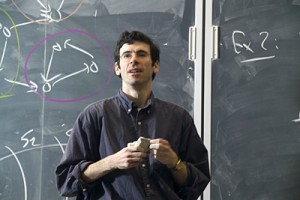
University Photography
Kleinberg is a typical researcher who is considered brilliant in the environment of computer science: PHD from MIT at age 25, winning major awards in science such as the Nevanllina Prize, offered every 4 years for contributions in Mathematical Aspects of Information Sciences, in MacArthur Fellowship, given to U.S. Citizen who “show exceptional merit and promise for continued and enhanced creative works”. He is also a member of US National Academy of Sciences, the US National Academy of Engineering, and the American Academy of Arts and Sciences.
For those not familiar with computer science or who are not well-informed users of the Internet, here is some more information about him, who will be one of the Keynote Speakers from the 2013 WWW Conference. Born in 1971, Jon Kleinberg is a computer scientist and professor at Cornell University and he is known by his students as the “Rebel King” (they seem to enjoy their classes, see comments on the website Rate My Professor ) but he most widely known for a number of books and articles on social networks and algorithms from the point of view of computer science.
Kleinberg is particularly known for his HITS algorithm, developed while he was at IBM. HITS is an algorithm for web search that builds on the eigenvector-based methods used in algorithms and HITS served as the full scale model for PageRank by recognizing that web pages or sites should be considered important not only if they are linked to by many others (as in PageRank), but also if they themselves link to many others. In fact, some credit Kleinberg’s work as the inspiration for PageRank, who was developed by Larry Page and used by the google web search engine.
Besides HITS and algorithms, Kleinberg has a strong record in the area of networks. One of his classic texts is an analysis of what is known as Slamm world phenomenon, the principle that we are all linked by short chains of acquaintances, or “six degrees of separation”. He thinks that this point is a basic statement about the abundance of short paths in a graph whose nodes are people, with links joining pairs who know one another.
In two lecture videos posted on the site VideoLectures, Kleinberg goes further in explaining the mechanisms of mathematical paths left in networks (in The Structure of Information Pathways in a Social Communication Network ) and also about the circulation flow of “memes” (Meme-tracking, Diffusion, and the Flow of On-Line Information). In the latter, in particular, Kleinberg explains a set of approaches for tracking pieces of text as they travel and mutate in these networks, applying these ideas to a set of related problems.
VIDEO: The Structure of Information Pathways in a Social Communication Network

VIDEO: Meme-tracking, Diffusion, and the Flow of On-Line Information

Now that you know something about Jon Kleinberg and understand more of their research, you should find it somewhat easier to understand why his lecture at the 22nd WWW will be one of the highlights of the event – whether you’re a well-informed person about computing or just someone interested in Internet and social networks.



















